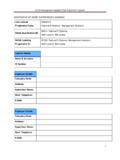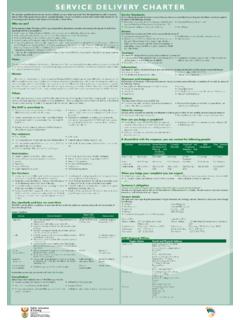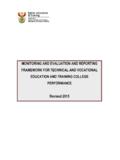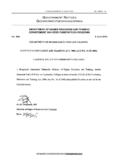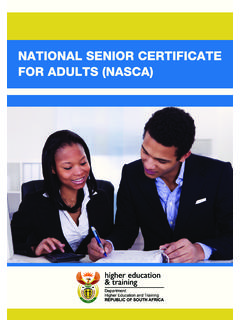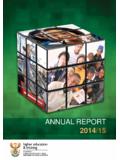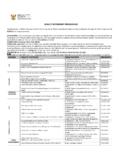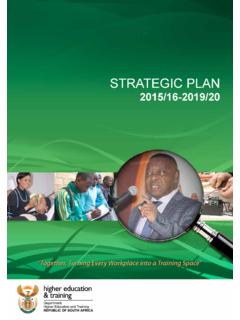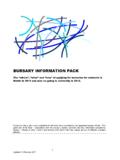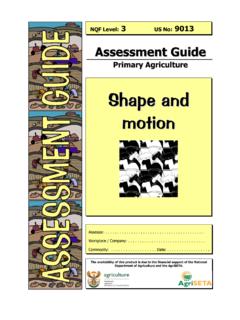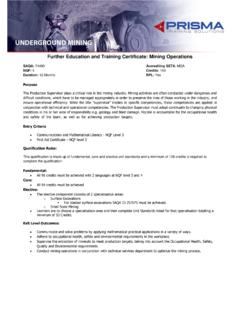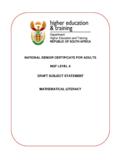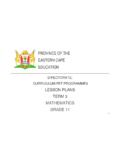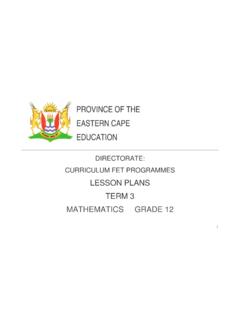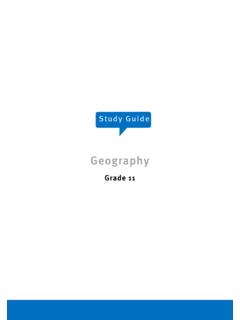Transcription of NATIONAL SENIOR CERTIFICATE FOR ADULTS …
1 NATIONAL SENIOR CERTIFICATE FOR ADULTS NQF LEVEL 4 draft subject statement mathematics 1 NASCA CURRICULUM mathematics (NQF LEVEL 4) TABLE OF CONTENTS Page 2 2 SPECIFIC 2 FOCUS OF CONTENT 3 WEIGHTING OF SUB-TOPIC CONTENT 4 Structure of examination 4 SUGGESTED STUDY 4 EXIT LEVEL OUTCOMES & ASSESSMENT 5 subject 7 Overview of each topic Prior knowledge required for each topic
2 Details of content coverage ASSESSMENT IN 25 External Assessment in 25 Weighting of levels of Cognitive 25 Descriptors for each cognitive 26 Moderation of 29 31 34 2 INTRODUCTION The NATIONAL SENIOR CERTIFICATE for ADULTS (NASCA) aims to provide evidence that the adult learners are equipped with a sufficiently substantial basis of discipline-based knowledge, skills and values to enhance meaningful social, political and economic participation, to form a basis for further and/or more specialist learning and possibly to enhance the likelihood of employment.
3 In these respects, the NASCA promotes the holistic development of adult learners. _____ SECTION 1 What is mathematics ? mathematics is a language that makes use of symbols and notations for describing numerical, geometric and graphical relationships. It is a human activity that involves observing, representing and investigating patterns and qualitative relationships in physical and social phenomena and between mathematical objects themselves. It helps to develop mental processes that enhance logical and critical thinking, accuracy and problem solving that will contribute in decision-making.
4 Mathematical problem solving enables us to understand the world (physical, social and economic) around us, and, most of all, to teach us to think creatively. Aims The mathematics curriculum is to provide students with the fundamental mathematical knowledge and skills. The general aims of the mathematics curriculum are to empower learners to: Develop positive attitudes towards mathematics ; Acquire the necessary mathematical knowledge, skills and values for continuous learning in mathematics and related disciplines, and for applications to the real world; Be able to understand and work with the number system Develop the necessary process skills for the acquisition and application of mathematical concepts and skills.
5 Develop the mathematical thinking, problem solving and modelling skills and apply these skills to formulate and solve problems; Recognise and use connections among mathematical ideas, and between mathematics and other disciplines; Provide the opportunity to develop in learners the ability to be methodical, to generalise, make conjectures and try to justify or prove them; Make effective use of a variety of mathematical tools (including information and communication technology tools) in the learning and application of mathematics ; Produce imaginative and creative work arising from mathematical ideas; Develop the abilities to reason logically, to communicate mathematically, and to learn cooperatively and independently; Collect, analyse and organise quantitative data to evaluate and comment on conclusions.
6 To prepare the learners for further education and training as well as the world of work. Specific Skills To develop essential mathematical skills the learner should: Develop the correct use of the language of mathematics ; Collect, analyse and organise quantitative data to evaluate and critique conclusions; Use mathematical process skills to identify, investigate and solve problems creatively and critically; Use spatial skills and properties of shapes and objects to identify, pose and solve problems creatively and critically.
7 Participate as responsible citizens in the life of local, NATIONAL and global communities; Communicate appropriately by using descriptions in words, graphs, symbols, tables and diagrams. 3 Focus of Content Areas mathematics in the NASCA curriculum covers the following four main content areas: 1. Number and number relationships 2. Functions, Graphs and Algebra 3. Space, shape and measurement 4. Data handling Each content area contributes towards the acquisition of the specific skills. The table below shows the main topics and sub-topics in the NASCA curriculum.
8 Content Topic Sub- Topics Number and number relationships Exponents and surds Number patterns Formulae to calculate the sum of Arithmetic and Geometric Sequences Application of the knowledge of geometric series to solve problems Investment and Loan options Functions, Graphs and Algebra Manipulation and simplification of algebraic expressions Solving of algebraic equations Function concept Various types of functions: straight line; parabola; hyperbola; exponential and trigonometric graphs Characteristics of functions Effects of parameters on graphs (manipulation of representations) Inverses of functions: straight line; parabola and exponential graphs Solving of cubic equations Space, shape and measurement Measurement: Volume and surface area of geometric objects.
9 Conjecture, prove and use circle geometry theorems Coordinate Geometry: distance between two points, gradient of a line, parallel and perpendicular lines, mid-point of a line segment, inclination of a line, equation of a line, equation of a circle and equation of a tangent to a circle Trigonometry: Definition of the trigonometric ratios , and ; special angles; reduction formulae; specific and general solutions to trigonometric equations; sine, cosine and area rules; compound and double angles; problems in 2 and 3- dimensions Data handling Univariate numerical ungrouped data: Measures of central tendency; five number summary; box and whisker diagrams; measures of dispersions Univariate numerical grouped data: Frequency distribution table; Ogive curve; quartile values; histograms; mean, median and mode Bivariate data: Variance and standard deviation of Bivariate data: Scatter plots; Correlation; Best fit function.
10 Regression lines 4 Weighting of sub-topic Content Areas The weighting of mathematics content areas serves two primary purposes: Firstly, the weighing gives guidance on the amount of time needed to address the content adequately within each content area; Secondly, the weighting gives guidance on the spread of content in the examination (especially end of the year summative assessment). Structure of the examination papers Description Duration Weightings (Marks) PAPER 1 3h Patterns, Sequences and Series 45 3 Finance, growth and decay 35 3 Functions, Graphs and Algebra 70 3 TOTAL 150 PAPER 2: 3h Data handling 30 3 Circle geometry & measurement 40 3 Co-ordinate geometry 30 3 Trigonometry 50 3 TOTAL 150 Suggested study hours mathematics is a 30 credit course, which relates to 300 notional study hours.
